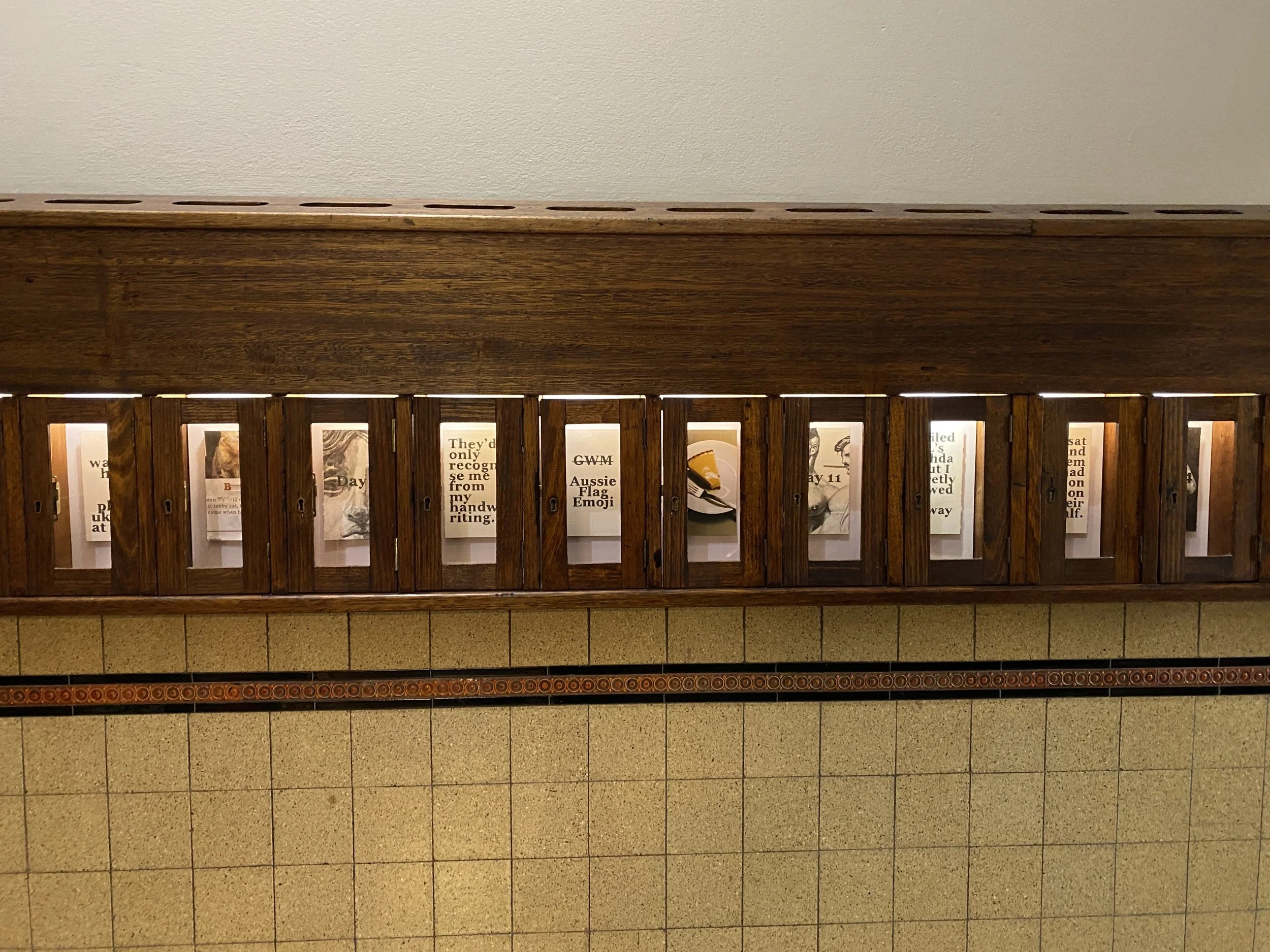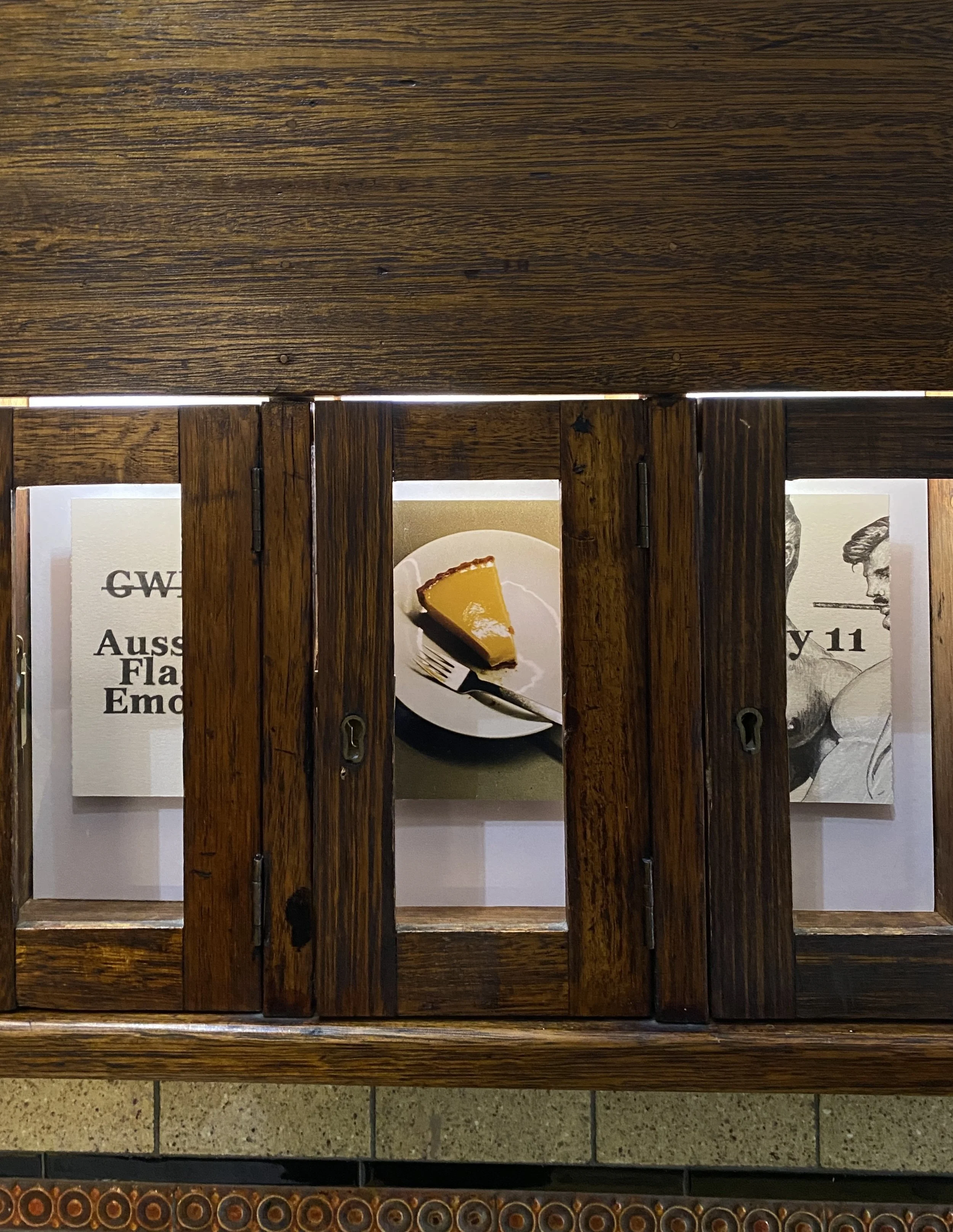No More Dreaming Tonight - Mailbox Art Space
Badra Aji’s exhibition No More Dreaming Tonight offers viewers various entry points for reflection on identity, race and the complexities of living as a queer person of colour in so-called Australia. A continuation of his work as a finalist for the 2023 Ramsay Art Prize, No More Dreaming Tonight presents a narrative drawn from Aji’s own lived experience. Through the nineteen mailboxes of the Mailbox Art Space, Aji pulls the viewer into a fragmented narrative over the course of twenty days in 2012, a time during which the artist ‘woke up as a white man.’ During this period, Aji reconciled with notions of identity and belonging in a world that privileges whiteness and heteronormativity. Oscillating between drawing, photographs, found objects and text, the works provide moments of knowing and unknowing, allowing the viewer to consider various histories and piece together storylines that may or may not exist.
Aji lays bare his twenty-day journey, each mailbox representing a single day of discovery and self-reckoning. Notably, Day 20 is intentionally missing. The absence suggestive of not only a physical void, but a conceptual provocation: What happens when something is withheld? What histories are lost, overlooked, or erased entirely? The absence of Day 20 leaves us grappling with stories so often ignored or forgotten – an invitation to confront uneasy silences that surround structures of race, sex and power. It is within this tension between presence and absence, knowing and unknowing, that Aji’s work in No More Dreaming Tonight comes alive. Last week, I had the pleasure of sitting down with Aji, who moved to Australia from Indonesia as a teenager. ‘Once upon a time,’ says Aji, ‘all I wanted was to be wanted and desired.’ No More Dreaming Tonight embodies a reconciliation of this longing. ‘If you look at the context of where I was at the time, I didn’t realise that to be wanted was actually to be white.’
While Aji’s exhibition is deeply personal, its themes are universal. The work might particularly resonate with those who have experienced estrangement and displacement due to migration, race or queerness. For Aji, his experience of fitting in correlated to becoming white, an experience marked with loss and self-awareness. The pressures between internal identity and external expectation form a thread throughout his practice. Aji’s use of text, photographs, historical artworks and personal imagery creates dialogue between the past and the present. Each work beckons a critique of dominant heteronormative narratives, while creating a reimagined space for marginalised voices. Aji expertly weaves personal narrative with symbolic gestures, drawing texts from his own journalling practice and returning to iconography rooted in the Western art historical canon, ultimately subverting familiar assumptions.
Aji welcomes you into his narrative through a passport photo of the artist overlaid with text denoting ‘Day 1’. Aji’s eyes are mostly obscured by the text, leaving the top of his head, nose, moustache and chin exposed, vulnerable. Through this photograph, I was introduced to the protagonist of this story, the artist, and drawn into the first day of his experience waking up as a white man.
As the exhibition progresses through Aji’s twenty-day journey, the narrative alternates between passive observation to active confrontation with whiteness. The mailbox denoting Day 7 contains a close-cropped drawing of the classical Apollo Belvedere sculpture, a quintessential Western ideal of beauty and perfection. Aji not only replicates Apollo’s face through precise drawing and thatching, but he recontextualises it within his own narrative, prompting questions around why this image has come to symbolise universal beauty. The image of Apollo is re-drawn at different historical moments over the course of the twenty days. Aji later draws Apollo based on Robert Mapplethorpe’s photograph Apollo 1988. ‘I like this idea of copying, copying, copying … at the same time we are maintaining this status quo of white being the ideal of beauty.’
The mailboxes for Day 11 and Day 17 contain drawings referencing Tom of Finland and Bailey Smith, the football player, respectively. Tom of Finland serves as a manifestation of how Aji anticipated the queer scene to feel in so-called Australia – safe, affirming and a place where he could be both desired and authentically himself – while Bailey Smith serves an embodiment of the New Age Apollo: blonde, muscular, celebrated, athletic. Each drawing, Aji tells me, depicts ‘a history which [he is] excluded from, or if anything, ideals that are not [him].’
I was intrigued by the significance of lemon tarts in the exhibition, a repeated motif in the works: Day 10, a photograph depicting a perfect-looking slice of lemon tart, and Day 13, text reading ‘I sat behind them and had a lemon tart on their behalf’. In Aji’s work, the lemon tart becomes a potent symbol of rupture. Lemons, a fruit native to Asia but redefined through European culinary traditions, mirror Aji’s own experience of migration and transformation. The lemon tart is not only a food he consumed during the twenty days, but also symbolises ways in which non-Western cultures can be celebrated in ways which feel extractive or incomplete.
Strikingly, Day 19 is an inversion of the artist’s passport photo, seemingly a rightful conclusion to the story, marking a return to a place of self-recognition. ‘The inversing is a returning to the state before,’ Aji reflects, ‘reconciling that twenty-day period.’
What is perhaps most remarkable about No More Dreaming Tonight is how Aji’s deeply personal experience resonates beyond the confines of his own narrative. While the exhibition draws on his unique story as a queer Indonesian immigrant, the themes of alienation, self-discovery and the search for belonging are relatable to anyone who has ever felt othered or excluded. For those who have struggled to find a place in their adopted homes or communities, Aji’s exhibition offers a mirror, allowing us to reflect on the systems of power that shape our daily lives. It is both an invitation to reflect and a call to confront the discomfort that comes with acknowledging these truths.
Aji’s exhibition is about becoming and unbecoming, about the fragmented nature of identity, and about the internal negotiations that we all make as we try to understand our place in the world. It is an honest, evocative and deeply moving exploration of the complexities of race, migration and queerness. It is a space where viewers are asked not just to witness, but to feel.
You have one day to catch Badra Aji’s exhibition No More Dreaming Tonight at Mailbox Art Space before it closes on Saturday August 2nd.



